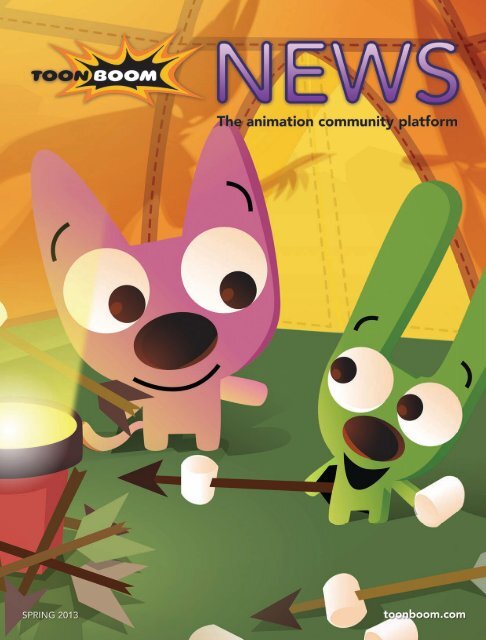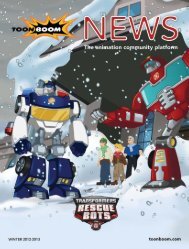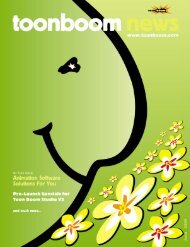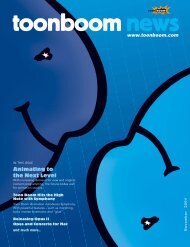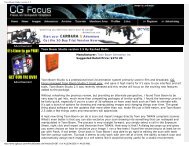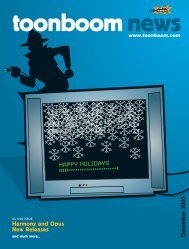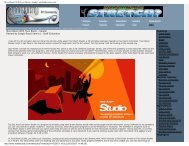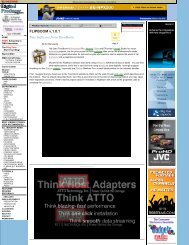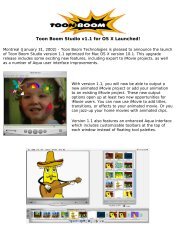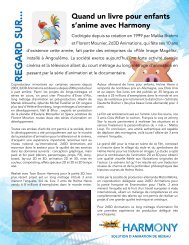Spring 2013 - Toon Boom Animation
Spring 2013 - Toon Boom Animation
Spring 2013 - Toon Boom Animation
- No tags were found...
Create successful ePaper yourself
Turn your PDF publications into a flip-book with our unique Google optimized e-Paper software.
Channeling CreativityTowards Infinity<strong>Toon</strong> <strong>Boom</strong> takes great pride in developingtechnologies that enable anyone to express their ideas.When customer feedback praises how comfortable theyfeel with the products, they’re thrilled to focus on whatmatters—expressing themselves visually. As our modernlifestyle revolves so intensely around technology, <strong>Toon</strong><strong>Boom</strong> strives to provide the best creative experiencepossible for all, on both desktops and tablets.While the team is globetrotting the world, the company moved to a new location, right in the Plateau area of Montreal.The Plateau is one of the most vibrant and dynamic districts with an abundance of multicultural entrepreneurs andbusinesses. We look forward to welcoming you here!TRADE SHOWS<strong>Toon</strong> <strong>Boom</strong> remains rooted in the field, with speakingopportunities in Canada and road trips planned to Asia,as well as Eastern and Western Europe. Joan Vogelesangwas a guest speaker at the National Capital IndiaForum in Ottawa and participated at the Doing Businessin India seminar at HEC Montreal. On the industry eventfront, after attending Rio Content Market <strong>2013</strong> (February20–22), Cartoon Movie (March 6–8), and AQUOPS(March 26–28), the team will attend MIPTV (Booth C-109)in Cannes, France (April 8–11), ExpoPixel in Bologna, Italy(April 15–17), and eLearning Africa in Windhoek, Namibia(May 29–31, <strong>2013</strong>). We hope to see you soon!AWARDSOn February 2, <strong>2013</strong>, the International Animated FilmSociety, ASIFA-Hollywood, granted the Ub Iwerks Awardfor the <strong>Toon</strong> <strong>Boom</strong> Pipeline at the 40th Annual AnnieAwards. As part of the juried awards category, the UbIwerks Award recognizes the technical advancements thatmake a significant impact on the art or industry of animation,enabling freelancers and studios to collaborate onlarge productions.The gala event gave the <strong>Toon</strong> <strong>Boom</strong> team a wonderfulopportunity to mingle and enjoy the moment with itscustomers and friends in the animation industry.toonboom.com/professionalsFrom left to right: Diedrich Bader (presenter), Francisco Del Cueto,Marisa Labrador, Joan Vogelesang, Lilly Vogelesang, Karina Bessoudoand Robert Dancik.This issue’s cover courtesy of BENT Image Lab<strong>Toon</strong> <strong>Boom</strong> <strong>Animation</strong> Inc.4200 St.Laurent Blvd, Suite 1020Montreal, Quebec, Canada H2W 2R2+1 514 278 8666toonboom.comPrinted in CanadaA Corus ® Entertainment Inc. Company2 <strong>Toon</strong> <strong>Boom</strong> News <strong>Spring</strong> <strong>2013</strong>
In View With Larry King Focuses On 21st Century EducationFeaturing <strong>Toon</strong> <strong>Boom</strong>Aired on Discovery Channel on January 28, <strong>2013</strong>, the In View with Larry King report on 21stcentury education illustrated the great benefits of using <strong>Toon</strong> <strong>Boom</strong>’s creative technology inthe classroom. As a test case, <strong>Toon</strong> <strong>Boom</strong> chose Bluffton Elementary School, South Carolina,for their students’ impressive achievements in a very short time, right after implementingthe Flip <strong>Boom</strong> line into their core curriculum. Indeed, during the first year of implementation,this innovative approach translated into an increase of up to 15% in overall marks throughoutthe core curriculum, maintaining a much higher performance than the state level. There wasalso an over 40% increase in science, 36% in math, 12% in social studies, and 26% in writingamongst African-American students.Integrating the arts into education goes far beyond teaching creative skills; it amplifies students’ learning experienceand opens their horizon to become whatever they aspire to be. During the <strong>2013</strong> Oscars ceremony, First Lady MichelleObama clearly stated that message which positions <strong>Toon</strong> <strong>Boom</strong>’s unique offerings for education as a natural companionto reach this goal.Watch all videos at toonboom.com/blufftonEDUCATION<strong>2013</strong> started off with two major announcements related to <strong>Toon</strong> <strong>Boom</strong>’s dedication to education.First, <strong>Toon</strong> <strong>Boom</strong> has recently joinedthe Arts Schools Network (ASN) inorder to collaboratively promote thebenefits of using arts as a medium ofcommunication to teach core curriculumwhile developing students’ creativity.During the <strong>Spring</strong> of <strong>2013</strong>, <strong>Toon</strong> <strong>Boom</strong>hosted a series of free 45-minute webinars on Animatingthe Core and The Power of Digital Storytelling. <strong>Toon</strong> <strong>Boom</strong>will also attend ASN’s Annual Conference in New York inOctober 2103. Their community of art leaders, schools,and organizations from around the world is very open tousing creative technologies to teach all subjects, engagetheir students, and stimulate their interests.artsschoolsnetwork.orgSecond, Canada’s Information and CommunicationsTechnology Council (ICTC) has recognized <strong>Toon</strong> <strong>Boom</strong>Studio and its curriculum as one of the best vehicles to teach21st century business and technology skills to Canadians tudent s. <strong>Toon</strong> <strong>Boom</strong> has been approved as an of ficial educ a-tional resource and curriculum to support the learning ofleading-edge skills among Canadian students throughone of ICTC’s youth and education initiative programs,Focus on IT (FIT). At a time when youth unemploymentis high, FIT provides the necessary building blocks for aninnovative learning experience and encourages studentsto acquire 21st century skills in business, technology, andcommunications while completing their secondary schooldiploma.Meeting the FIT standards is a testament of <strong>Toon</strong> <strong>Boom</strong>Studio’s significant pedagogic impact not only in Canada,but also in the United States and beyond.ICTC President and CEO NamirAnani, commented, “It is through theeducational innovation of organizations,such as <strong>Toon</strong> <strong>Boom</strong>, that our Canadianstudents have access to first-classcurriculum that prepares Canadians forthe ICT jobs of the future. <strong>Toon</strong> <strong>Boom</strong> Studio engagesstudents in a meaningful way, exposing them to thepossibility of working in the interactive media field, andpreparing them for the workforce through instilling criticalbusiness and technology skills in them.”This great accomplishment will be carried over all of<strong>Toon</strong> <strong>Boom</strong>’s educational initiatives worldwide.ictc-ctic.caProud recipient of:Emmy-AwardTechnology<strong>Toon</strong> <strong>Boom</strong> News <strong>Spring</strong> <strong>2013</strong>3
TECHNOLOGY NEWS: PROFESSIONALSFrom Mind to Media with<strong>Toon</strong> <strong>Boom</strong> Storyboard Pro 4Following its crowning with a 2012 Primetime Emmy® EngineeringAward, <strong>Toon</strong> <strong>Boom</strong> Storyboard Pro has leaped forward with a new versionthat efficiently and elegantly caters to live-action, gaming, and animationstudios alike.• Use Storyboard Proto plan live actionprojects, cameraangles, action, sceneorder, and scriptintegration for televisionor feature filmproduction• Take advantage ofStoryboard Pro’s3D toolset to planmultiplane scenes,integrate 3Dobjects, and createbasic animation foradvanced animatics• Create and draw on•Plan animated projects,from shorts topixel-based bitmaplayerstelevision and filmprojects, makinguse of the advanced• Create storyboardsdrawing tools, layerfor games, planninganimation, cameraworkflows, and cutanimation, and scriptscenesintegration• Use the new pixelbasedcolour picker,and save colours inthe palette for reuse• Export your projectfrom Storyboard Proto Premiere, FinalCut Pro, or Avid foranimatics and liveaction projects, andto PDF for print• Export fromStoryboard Pro toAnimate, AnimatePro, Harmony, orFBX for 2D, 3D,and mixed mediaprojects• Create custombitmap-style brushesWatch the demo video and try it now!toonboom.com/storyboardpro4 <strong>Toon</strong> <strong>Boom</strong> News <strong>Spring</strong> <strong>2013</strong>
TOON BOOM STARThis section is dedicated to <strong>Toon</strong> <strong>Boom</strong> employees. In eachissue, we will introduce you to the people behind the technologyand put a face to the voice you may have spoken to.Vladyslav Pronin has been part of <strong>Toon</strong> <strong>Boom</strong>’s WebMarketing team since November 2011. He takes care ofemail marketing, paid search programs, affiliate marketing,online ad placement, content marketing as well asweb analytics. Targeting multiple channels, Vlad alsomanages the weekly campaigns, which include promotions,upcoming events, announcements, social mediacontests and advertising and electronic newsletters. Tobring quality traffic to the website, he regularly conductskeyword research for organic and paid search. Keeping<strong>Toon</strong> <strong>Boom</strong>’s electronic communications fresh and effectiveis one of Vlad’s key goals. Subscription, engagement,and conversion form the basis of all the programs he overseesand delivers. Recently, he worked on migrating theaffiliate program to a new platform to establish a betterflow of communication with affiliates and to keep themaware of latest sales, products and content updates. Vladis a graduate of McGill University with a Diploma in InformationTechnology and Internet Business. Before joining<strong>Toon</strong> <strong>Boom</strong>, he worked for Atelier ID on brand buildingand online program mandates for technology companies,in particular, related to military simulation and ERP software.Originally from Kiev, Ukraine, Vlad worked in filmproduction and advertising at Gulliver Film for six years,offering production services throughout Europe. Then,he moved to New York where he worked in fashion andphotography for two years. On a personal note, Vladnurtures two passions: the first one is music. Trained asa classical pianist, he is now producing electronic music.Vlad has extensively read about academic and electronicdance music history, its social impact and its culmination inrave revolution of the late 80s. His other passion is classicalEuropean cinema and conceptual films featuring directors,such as Michelangelo Antonioni, Jean-Luc Godard, DavidLynch, Jim Jarmusch, to name a few. Quite a nice mix ofpersonal interests and technology background!<strong>Toon</strong> <strong>Boom</strong> News <strong>Spring</strong> <strong>2013</strong>5
6 <strong>Toon</strong> <strong>Boom</strong> News <strong>Spring</strong> <strong>2013</strong>
INDUSTRY TIPSImage courtesy of the <strong>Toon</strong> <strong>Boom</strong> Multimedia and Content Creation TeamMaking the Most of Script Notesby Donna LisaFor all scriptwriters, including myself, a completedfirst draft is like a newborn. Writers tend to be protectiveof their “babies”. It’s not easy for scribes to expose theirinfant scripts to the scrutiny of notes, but they know it’s thebest way to help their creations grow.Why are notes worth the risk of exposure? How canthey help? I’ve found that insightful notes can improveall aspects of my scripts: dialogue, pacing, characters,relationships, humor, visual impact, and marketability. Theprocess of giving and receiving notes can be a gracefuldance, when the writer and note-giver are in sync, butsometimes the dance can be awkward. There are thingsto consider when working together in this reciprocalrelationship.I asked three writers, a consultant, and a producerthe same question; “What is the most important thing toremember when giving and receiving notes?” The writersagreed that being open to criticism is essential.Writer Mike Rabb explains, “When it comes to takingnotes you have to have a thick skin. Don’t fall so in lovewith your writing that you can’t hear what the persongiving notes is saying, but remember that critiques aresubjective. It’s up to you to use what works and ignore therest, unless you’re being paid. Then your choice to ignoreis somewhat limited.”Writer Monique Gramby concurs, “Don’t take notespersonally. As a children’s writer, it’s important to benimble and flexible in our ever changing market. I viewnotes as another tool in my arsenal to help me deliver abetter, tighter script!”Writer Kevin Caruso prefers collective notes, “A writermust be a sponge when receiving notes. It’s always betterto have several readers, trusted readers, read the material.Usually, the consensus of notes is a conscientious methodto understand what works and what flops.”From the perspective of consultants and producers,constructive notes can be illuminating. Consultant LisaGoldman explains, “The notes you give a writer must bein the best interest of the story and help make it strongeron every front. Being the fresh eyes on a script allows thenote giver to see things the writer can’t because he/she istoo close to it.”Producer/Development Consultant Bonita Siegelbelieves the core of the story is tantamount. “Whengiving notes, determining the intent of the writer comesfirst. The notes should help to achieve and strengthen thatgoal. When receiving notes, writers should hold onto thecore concept, but remain open to ideas that add details. Ifnotes change the core concept, discussion is required withthe note-giver.”Clearly, the giving and receiving of notes can be awonderfully collaborative process when both the writerand note-giver approach this relationship with a receptive,respectful mindset.Donna Lisa's scripts and songs have beenhonored by iParenting , NAPPA, and other mediaorganizations. Her screenplay, Kheng KhengCrocodile, is under Agreement with Flat RockPictures. Donna’s series, Bat Cat And Bitsy, willbe produced by Engine 15 Media. Donna hasbeen working with producer, Bonita Siegel, onher series, Toucan You Can! Her CD (same title)received twenty international awards. Donna isA&R Coordinator and a contributing songwriteron Playful Journeys.<strong>Toon</strong> <strong>Boom</strong> News <strong>Spring</strong> <strong>2013</strong>7
INDUSTRY TIPSImage courtesy of the <strong>Toon</strong> <strong>Boom</strong> Multimedia and Content Creation TeamI Don’t Own My Work? What?!by Deborah Gonzalez, Esq.You've labored for hours but it was worth it–thecharacters are technically perfect and artfully crafted. Andyou’ve just been informed you can’t do anything with itbecause it is not yours. How could this happen? Didn’tI tell you in a previous article that copyrights belong tothe "author" of the creation and you are the author if youcreated it? In most cases the answer is yes, but sometimesrights of ownership and copyrights belong to someoneother than the person who created it. How? For manyartists it comes down to three dirty words–“work for hire.”The “work for hire” doctrine basically states that anemployer owns whatever an employee creates. Accordingto the Copyright Act, this can occur in one of two ways:1. A work prepared by an employee within the scopeof his or her employment; or2. A work specially ordered or commissioned for usea. As a contribution to a collective workb. As a part of a motion picture or other audiovisualworkc. As a translationd. As a supplementary worke. As a compilationf. As an instructional textg. As a testh. As answer material for a testi. As an atlasIF the parties expressly agree in a written instrumentsigned by them that the work shall be considered a workmade for hire. (See Copyright Office’s Circular #9, WorksMade for Hire). 1How does this play out for animators? Well if you workfor a studio doing animation for their projects, you wouldfall under scenario #1 above. Disney Studios, Nickelodeon,and Cartoon Network are examples of companies thatwould have this as part of their standard employmentcontract for animators.If the work you were doing was part of a feature-lengthanimation you could fall under scenario #2b above. Pixarand DreamWorks would be examples, but also smallanimation production studios working on a specific projectfor someone other than them.It would be important for you as an animator to readthe employment contract you are given before startingthat new job at the studio and see how they define “workfor hire.” It could be pretty broad, encompassing eventhings you do outside of your work hours and work placeIF certain conditions are met–things like using the studio’sequipment (hardware, software, tools, etc.) or if theywithhold taxes from your paycheck.Perhaps you’re not an employee but a freelancer?Does your contract read “independent contractor” or“on commission?” Even if it does, read the clauses thattalk about intellectual property–does it state you are8 <strong>Toon</strong> <strong>Boom</strong> News <strong>Spring</strong> <strong>2013</strong>
CASE STUDY: TIMBUKTOONS (CONTINUED)the project calls for traditional media or actual handdrawnanimation."We have a traditional animation desk, but honestlyHarmony's drawing tools are so true to traditional mediathat we rarely use it," explained Todd. "It works as a niceprop and the kids all love to play with it when they cometo the studio!"Whether the production is fully animated or riggedcharacteranimation, Timbuktoons uses Storyboard Profor boarding and animatics and export the scenes directlyto Harmony.For the fully animatedOrbie scenes, they did arough animation pass, cleanup, digital ink and paint, andthen shadow and highlighteffects directly in Harmony.For the rigged charactersin the Tick Tock short, theyreceived files from Tod Carterat Brain Freeze Entertainment(producer of Episode 1),then developed three morerigged characters for Episode2.Everything was creatednatively in Harmony includingbackgrounds and effects."The fact that we could get production-readyHarmony assets from another studio proved to us thatHarmony was definitely a good fit for our TimbukCloudTeam model," stated Sean.Timbuktoons now uses all Adobe products for postproduction(Premiere, After Effects, Audition) afterswitching from Apple Final Cut Pro Suite last year."We're really glad we added Harmony to our capabilities.The integration with Storyboard Pro, the amazingdrawing tools, the powerful rigging and deform tools,the 3D camera, and several other features all helped savetime and have set us up to produce high-end animationaffordably at a time when the economy and amount ofcompetition demands it," stated Todd."2012 was a learning curve year for us and there'snothing better than an actual project to force you tofigure it all out,” he continued.“Now that we have a few Harmony projects underout belt, we're going to be aggressive about divingdeeper into Harmony's capabilities, as well as marketingour Storyboard Pro and Harmony services to studiosand production companies that may need help with theirproductions.”Timbuktoons has big plans for <strong>2013</strong>. Preparing to celebrateits 10-year anniversary has spurred the company toidentify new goals for the next decade and thoroughlyupdate its business plan to take advantage of the currentstate of the advertising, animation, and gaming industries.They will be leading workshops at CTN <strong>Animation</strong>Expo in Burbank, CA again this year and further establishingthemselves as a key 2D animation developmentand production studio.They are also developing funding plans for their IPsand will begin seeking investors for the first time in thehistory of the company. •timbuktoons.com12 <strong>Toon</strong> <strong>Boom</strong> News <strong>Spring</strong> <strong>2013</strong>
CASE STUDY: BIG JUMP PRODUCTIONS (CONTINUED)50% cut-out animation, combining character builds withold school drawings to create the classical look and feel.Spanning over six months, this production created close tosixty jobs, including four storyboard artists, thirty animators,six builders, and four compositors.This production was headed up by Rick Morrison,Studio Producer; Rodrigo Amador, Technical Director;and Cory Morrison, Line Producer. The productioncrew included these talented people: Shannan Thomson,Line Producer; Sarah Mercy and Jason Boose, Directors;Kris Pearn, Creative Consultant; Colin Tsandilis andAzalia Shin-Chin Liu, <strong>Animation</strong> Director Assistants; RobLundy, Builds Supervisor; David Badour and Robyn Moir,Art Direction; Joshua Gay, Location Design and LayoutSupervisor; Allan Stewart, Lead Character Designer;Darren Ward, Props andVehicle Design; ScottArmstrong, Lead 3DDesigner; Jennifer Myers,Assembly Supervisor; SyNguyen, Lead Compositor;Miranda Brewer andMathieu Hains, SeniorAnimators; and DanielElder, FX <strong>Animation</strong> Lead.Amberwood Entertainmentprovided the teamwith approved script andvoices—one of them beingDon Cherry, one of Canada’smost famous hockey figures. The pre-productionphase took approximately seven to eight weeks and wentvery smoothly.Moving on to production, Harmony was put to fulluse for animation and compositing. All designs (locationand characters) including turnarounds were first donein Photoshop and then sent to their Builds Department.Props were designed and created in Harmony, so theycould be broken up as they were created. The Builds teamredrew the characters in Harmony focusing on extensivebreakdowns for the facial features, hair, and head structureswhile keeping the bodies (arms and legs) very simple.“There are 180 characters in total, which represents animpressive library of assets,” explained Cory Morrison.“All animators had a Cintiq pen display which allowedthem to create extreme subtleties to enhance expressionin the characters’ faces. The animators then hand drew thearms and legs to achieve the desired look. Each animatorwas assigned a number of sequences and all animationwas completed within five weeks,” he continued. Oncedesign was complete, they turned their attention to colour.Working together, the directors and art directors startedto flesh out the colour palette for the show.Design was being completed during the storyboardprocess. The pipeline was set up so the board artistscould pitch their sequences to the directors, make revisionsand implement them. Once the board was completeand designs done, layout followed. Production layout wasexecuted in Photoshop as tight roughs; once approved,the art moved to background paint. At this stage, all lineswere removed allowing the BG elements to be definedonly by colour.With over 520 shots to complete, the hockey arenaat the head and tail of the show was built and laid outin Maya to achieve the integrity of the ice and surroundingstructure, eliminating inconsistencies and allowing fora timely delivery. The Maya sequences, including ambitiouscamera moves, were imported into Harmony for theanimators to complete the shots. “The most challengingwere those scenes that contained crowds in the arena.14 <strong>Toon</strong> <strong>Boom</strong> News <strong>Spring</strong> <strong>2013</strong>
In addition to the 3D arena, it included the crowd cheeringanimation, as well as the ten players on the ice. Over 90stand-alone characters where designed to fill the stands.They were all drawn in Photoshop and individually layeredin Harmony at the composite stage. We created roughly 20cheering cycles using deformers on the actual Photoshopfiles to achieve the desired look without having to do newbuilds. We then speckled the characters in each crowdshot to bring the audience to life. It worked wonders,”stated Rodrigo.The Assembly Department managed all the assets,carefully referencing the storyboard along with detailedlead sheets and assembling each shot with the appropriatebuilds, background, and design for the animation team.”We initially focused on shots that required FXelements, moving them quickly into animation. As shotswere completed, they went to composite,” added RodrigoAmador.In parallel with Harmony, BIG JUMP extensively usedManager. Some of the team working on the project waslocated remotely, including both animation directors. Theyprovided each one with a stand-alone version of Harmonyalong with the files required to deliver their portion of theanimation. “Manager has been integral in keeping everythingefficient and most importantly, keeping the lines ofcommunication open,” shared Rick Morrison. “Combiningin-house with remote talent enables us to grow the studioas production requires, while keeping the overhead down.This approach allows us to tap into talent pools throughoutOntario that we could not access otherwise. This translatesinto cost efficiencies which are passed on to our clients,”added Rick Morrison.“If it was not for the <strong>Toon</strong> <strong>Boom</strong> pipeline, we wouldnot have been able to do the project. It is so much moreefficient. We created a lot of drawings during the productionand <strong>Toon</strong> <strong>Boom</strong> is by far superior with its ability todraw directly into the system. At BIG JUMP it is paramountthat we keep the artists at the heart of the creative. TheMagic Hockey Skates was inspired by a traditional sensibilityand we strived to maintain that unique look and feel,”concluded Rick Morrison.BIG JUMP has its roots firmly planted as an animationproduction services facility and that will not change. Inaddition to being a source for producers and broadcastersglobally, they are venturing into proprietary IP. Thetransition is a challenging one to say the least, thus theywill not be venturing out alone. BIG JUMP is presently indiscussions with various partners in Canada and abroad toassist them in realizing their concepts to the screen. Lookfor them at the Kidscreen Summit <strong>2013</strong>! •bigjumpproductions.com<strong>Toon</strong> <strong>Boom</strong> News <strong>Spring</strong> <strong>2013</strong> 15
CASE STUDY: BENT IMAGE LABImages courtesy of BENT Image LabMIGRATING TO HARMONYBENT Image Lab is a Portland, Oregon based production company and creative laboratory, known for meldingart, design, and storytelling. It’s a place where the brightest ideas are driven with an artist’s passion andrealized through the use of cutting-edge technology.Established in 2002, BENT specializes in wildly creativespots and videos that range from the frenetic to thedeeply moving. Koodo Mobile, Golden Grahams, Microsoft,Diet Dr. Pepper, Mastercard, Thom Yorke, ModestMouse, They Might Be Giants, Coca-Cola, Guitar Hero,Cartoon Network, TLC, Hallmark Channel, NBC’s Grimm,IFC’s Portlandia and film directors Todd Haynes and GusVan Sant are just a few of the high-profile clients that havecalled on BENT for some of their quirky, highly originalBENT Image Lab ExecutiveProducer Ray Di Carlo“hoops&yoyo”Director Rob Shawwork. BENT’s long list of spots, music videos, animatedfilms, and promos has earned impressive recognition fromtop film festivals and industry shows, including SXSW, theClios, Cannes, Sundance, the Chicago Film Festival, AICP/MoMA, the Rosey awards, the Broadcast Design Awards,the Tribeca Film Festival, the Rotterdam Film Festival,and the Florida Film Festival. BENT’s principals are DavidDaniels, Chel White, Ray Di Carlo and Tsui Ling Toomer.BENT was mandated by the Hallmark Channel tocreate a fun animated short for Halloween using thepopular ecard characters Hoops (a pink cat) and Yoyo (agreen bunny). The plot brings together both characterswho get trapped in a haunted mall on Halloween night.Entitled hoops&yoyo's Haunted Halloween, the 21-minuteTV special aired October 26, 2012.To create this delightful project, the team included RayDi Carlo, Executive Producer; Rob Shaw, Director; TsuiLing Toomer, Producer; and, Sam Niemann, <strong>Animation</strong>Supervisor. On the Hallmark side, the team gathered JodiSchade, Executive Producer; Diana Larson Stuart, ExecutiveProducer; Shawn McClaren, Executive Producer;and Peter Martin, Production Designer.16 <strong>Toon</strong> <strong>Boom</strong> News <strong>Spring</strong> <strong>2013</strong>
This was an opportunity to progressively integrate<strong>Toon</strong> <strong>Boom</strong> Harmony into the hoops&yoyo's productionprocess, the team could appreciate the significant benefitsit could bring to this project in terms of animation quality.“A lot of thought and research went into the decision touse Harmony. hoops&yoyo’s Haunted Halloween couldhave been done with Flash, a program and a pipeline thatpeople at the studio and freelancers were already familiarand comfortable with. Ultimately, Harmony’s capabilitiesmade it a worthwhile decision, and I believe the cartoonwe made could not have been done with Flash. Our finalproduct was completed on time and looks great in largepart thanks to Harmony,” stated Sam Niemann.Once the storyboards were approved, the editor brokeup the animatic into individual scenes, which the animatorimported into Harmony to use for reference. “Each scenewas saved as its own Harmony project file. The animatorshad access to a library of character models, rigs, propsand backgrounds, prepared beforehand, that they couldimport into their scene as needed,” he explained.The overall production workflow included a combinationof Illustrator, Harmony, and After Effects. “Theworkflow felt a lot like a 3D CG workflow to me, whereyou’re animating assets in scenes to a camera. The team atHallmark created illustrations and designs, which we eitherused or referenced in the creation of files for Harmony.One of the animators did a lot of scene set up where heimported layers from an .ai file into Harmony scenes. Ananimation rigger would then bring in the characters, breakthem into the necessary pieces and them rig them withbones and deformers in Harmony. The characters andbackground would be combined in each scene with acamera. The animator would animate the character andthen export layers for final compositing in After Effects.This allowed us to develop some moody looks for thespecial while maintaining a relatively flexible workflow,”added Rob Shaw.Animators extensively used some of Harmony’s innovativefeatures, the first one being the deformation tools.“The characters in hoops&yoyo's Haunted Halloweenare very graphic, very flat and distinct. It was a fun challengefor the animators to give these little guys life andpersonality. Harmony’s deformation tools added flexibilityand allowed us a great deal of control and subtlety intheir performances, helping us create fun, lively characteranimation while maintaining the character’s importantgraphic elements,” shared Sam.Another great feature was the lip sync tool. hoops&yoyohave loud, funny voices and limited mouth shapes thatdon’t necessarily conform to the usual phonemes, (not tomention they often talk over each other), so Harmony’sbuilt-in Lip Sync tool almost did do a perfect job for us andhelped a lot. It could get us 80%–90% of the way there,making it necessary to make just a few hand adjustmentsto the lip sync,” continued Sam.<strong>Animation</strong> Supervisor for “hoops&yoyo’s HauntedHalloween” Sam Niemann works on the show<strong>Toon</strong> <strong>Boom</strong> News <strong>Spring</strong> <strong>2013</strong> 17
CASE STUDY: BENT IMAGE LAB (CONTINUED)Fig. 1Fig. 2Then, the multiplane camera served theproject very well: “The way Harmony uses thecamera module and a virtual 3D space madecreating convincing parallaxing motions abreeze. We had lots of fun animating our charactersfleeing ghosts in a high-speed (and slowmotion) foot chase through a shopping mall,and careening dangerously through downtownin their car! There’s even a scene where theydrive their car through a tunnel that looks somuch better than it might have because I wasable to actually build a virtual tunnel, and actually(virtually) drive the car in Z space throughit,” confided Sam. (Fig. 1)Moving on to 2D and 3D integration,Harmony’s latest version helped to push theenvelope creatively. “hoops&yoyo's HauntedHalloween is a beautifully designed 2D showwith a very flat, graphic style, but we did bringin a couple of 3D elements to great effect Ithink. hoops&yoyo have a very handsome 3Dcar that zips recklessly through town! And whenthe script called for our characters to be runningthrough the shopping mall while trapped insidea tent, like a hamster in a ball, it begged to berealized in 3D animation. The way Harmonyintegrates the 3D elements into those scenesallowed us to take advantage of some fun 3Danimation, nestling it nicely in our graphic 2Dworld,” he continued. (Fig. 2)At this point in time, the compositorspreferred using After Affects to apply the finalcompositing. However, some of them were18 <strong>Toon</strong> <strong>Boom</strong> News <strong>Spring</strong> <strong>2013</strong>
able to experiment with Harmony’s powerful compositingengine. “Though we left much of our FX animation to ourcompositor and After Effects, we did have the opportunityto take advantage of some of Harmony’s effects modules.For example, our characters’ bodies, heads, arms, and legsare a flat shape and a solid color, so when a character’s armwould pass over their head or body, it would essentiallyappear to disappear. We were able to rig the characterswith a set of modules (cutter, tone, shadow) so that wheneveran arm passed over another body part, it wouldautomatically produce a drop shadow, as well as automaticallytrimming the arm to the body shape,” explained Sam.(Fig. 3)At the rendering stage, Harmonydemonstrated again its advanced capabilities.“Since we wanted all of the elementsin a scene exported separately, so theycould be more easily manipulated by ourcompositors, rendering our scenes couldhave been someone’s full time job, butwith Harmony’s render network, sceneswere easy to set up, so that with oneclick all the separate elements would beexported, properly named, and wherethey belong,” he concluded.BENT has always been a companythat has prided itself on the idea of notpredetermining what technical process orsoftware platform a project should followuntil they have gathered all of the relevantinformation necessary to make the propercall. “Once <strong>Toon</strong> <strong>Boom</strong> got its foot in theBent door it has garnered an ever-increasingpresence in our workflow, as we are finding again andagain that it can be used to enhance the creative processfor many of our productions,” admitted Ray Di Carlo.Considering the high calibre of BENT’s executive andcreative team, the <strong>Toon</strong> <strong>Boom</strong> pipeline will surely act astheir robust production backbone to create animationeffectively and impress their customers and audienceseven more. •bentimagelab.comSam Niemann (in doorway), Director Rob Shaw, Editor BenBlankenship (at computer) and Line Producer Michel Jackson (right)discuss direction for “hoops&yoyo’s Haunted Halloween”Fig. 3<strong>Toon</strong> <strong>Boom</strong> News <strong>Spring</strong> <strong>2013</strong> 19
FREELANCERS: SHERM COHENEfficient Storytelling fromAn ExpertTOON BOOM CERTIFIEDWith nineteen years in the industry, ShermCohen is a cartoonist, writer, and storyboardartist. He’s also <strong>Toon</strong> <strong>Boom</strong> Storyboard ProCertified. His track record and impressivecareer speak of his talent and love for the artof animation.Following his education at The Joe Kubert School ofCartooning, Sherm got his start in animation at Nickelodeonon The Ren and Stimpy Show as a character layoutartist, followed by a three-year stint on Hey Arnold asstoryboard artist and director. In early 1998, Sherm Cohenwas invited by SpongeBob creator Steve Hillenburg tobe part of the original SpongeBob SquarePants crew asa writer, storyboard artist, and director. “I'm most proudof the work I've done on SpongeBob SquarePants—it'scertainly the project that affected more people thananything else. When I see people decorating their officeswith SpongeBob drawings, or when I see kids walkingaround singing the F.U.N. song... it just makes me feel veryhappy to know that I've made other people's lives happythrough my cartooning. I've also enjoyed teaching storyboardingthrough my online tutorials. When I hear fromsomeone that my tutorials have made a difference, thatmakes all the work worthwhile,” shared Sherm.After SpongeBob's fourth season, Sherm created hisfirst book, Cartooning: Character Design, published byWalter Foster Publications. Since 2006, Sherm has beenworking as a storyboard artist, supervisor and director atWalt Disney Studios on shows including Phineas and Ferb,Kick Buttowski and Fish Hooks. He was nominated for anEmmy ® for directing Kick Buttowski’s first season. Sherm'slatest project involves creating and teaching the StoryboardSecrets Online/DVD Course.“I started using Storyboard Pro while I was doing storyboardson Phineas and Ferb. I kind of eased into it by justworking on one section of the storyboard in StoryboardPro, while still drawing the rest of the storyboard withpencil on paper. Gradually, I felt comfortable enough todraw the entire storyboard with Storyboard Pro, and bynow I can't imagine working on storyboards without it,”explained Sherm.“When I moved to work on Kick Buttowski, usingStoryboard Pro became a lot more important. At thispoint I was working as a storyboard supervisor and director,which means I have to be working on many differentstoryboards at any given time. Working in StoryboardPro makes it easier than ever before to create revisions,add new scenes, reframe shots, and rearrange panels asneeded,” he added.As part of his creative process, Sherm still draws histhumbnails on regular copy paper to let his ideas flow andknow where he is going with the story. Sometimes, he willwrite the dialog first, because he can type faster than hedraws. Then, he starts drawing in Storyboard Pro, roughingin with a big fat brush in light blue and cleaning upon a new layer. Sherm will use Photoshop only to resize,transform, or blur an image. “I like to keep the file size aslow as possible for imported images, so I shrink them inPhotoshop before importing them. Also, the <strong>Toon</strong> <strong>Boom</strong>perspective tool only works on non-textured vector art, soI need to use Photoshop to transform images. On the rareoccasion that I need to add a blur effect (for soft focus) Iwill use Photoshop for that effect as well,” he commented.Sherm keeps a well-organized library of assets, includingbackgrounds in Storyboard Pro to conveniently reusethem as needed.“In Storyboard Pro, using a light table and the onionskinning make the drawing experience very intuitive.It really frees me up to know that I can draw big sloppyroughs, and then do my cleanups on another layer. I alsoreally love the animation disc feature—it's nice to be ableto rotate the workspace the same way that I would turn thispaper around for getting the best stroke,” stated Sherm.Many times during the revision process, the framingneeds to be changed. “The easiest way I've found is to usethe camera tool. Simply resizing the camera frame allowsme to create the framing I want over as many panels orscenes that I want,” he added.There are several other Storyboard Pro features Shermtakes advantage of: “Using the Select tool to resizedrawing elements has also saved me hours of time thatI spent going back and forth to the photocopy machine.The Library tool makes it easy to reuse a character, prop, orbackground...especially something as tedious as a schoolImages courtesy of Sherm Cohen20 <strong>Toon</strong> <strong>Boom</strong> News <strong>Spring</strong> <strong>2013</strong>
desk! I use a couple of custom brushes, including a brushwith a semitransparent grey tone which enables me to addshading right on top of the artwork. The “draw behind”feature is also one I use all the time. With a white brush,I use this feature to paint a white backing on characters,so they stand out from the background layer and makethem opaque. Many artists will cut and erase sections ofthe backgrounds to accommodate the characters, but forme, using the paintbrush to opaque the figures lets memove them around without disturbing the background,”he explained.“I feel like I draw with more boldness and confidencethan before. Having the undo feature lets me draw a bitmore spontaneously because I can always just undo theline if I don’t like it. It also lets me focus more on posingand acting because I don’t need to worry about size andplacement so much. I can always resize and move individualelements after I draw them,” shared Sherm.Fish Hooks is a storyboard-driven show with 10 to12 artists on board. Storyboard artists get a completeepisode from beginning to end and write up the story,including all jokes and dialogue, based on an outline.“This is creatively rewarding,” admitted Sherm. For aneleven-minute episode, it takes five weeks to completethe storyboards. About one week is allocated to createthe thumbnails, another week for rough drawings andgetting input from the directors and on the third week,pitching to the crew and executives. The last two weeksare spent on clean up before the revision process starts.As the Storyboard supervisor, Sherm makes one morepass on all storyboards, making sure all compositions andexpressions work, and listening to the audio tracks. Then,the storyboards are exported in two formats: the first inCSV for the production staff to type up the script andhave the voices recorded in the sound studio. The finalaudio tracks are then sent to the editor. The second formatis in TGA for the editor who can easily keep track of thescene and panel numbers. They can match the audio with<strong>Toon</strong> <strong>Boom</strong> News <strong>Spring</strong> <strong>2013</strong> 21
FREELANCERSthe storyboard files to generate an animatic. “We alwaysadd to the storyboards. In the editing room, the directorcan draw directly on the boards using a Cintiq to makeimprovements,” stated Sherm.At this point, the revised animated storyboard goesback to Sherm. The revision team cleans up the addedposes and they use the Panel tracking feature to exportonly the panels that were revised and send them to theeditor to generate a new animatic. This process is repeatedand refined approximately three times.Once finalized, the storyboards in PDF format andanimatics are sent to Mercury Filmworks in Ottawa,Canada. “They do great work. This is the only time inmy career that the animation comes back better than I’dhoped it would,” confided Sherm.Compared to his previous work methods, Shermexperienced significant productivity gains using StoryboardPro. “I don’t have piles of paper all over my desk,and I don’t need to keep walking down the hall to thephotocopy machine if I need to resize a scene or reusea background. Another huge time saver is the way StoryboardPro automatically numbers all the scenes andpanels...for a 700-panel board that used to be a long andtedious task. It used to be hard to add extra panels afterthe first pass...you had to cut up the pages and renumberby hand. Another important time-saver is the way I cantype in the dialogue and action...or even use cut and pastewhen I was working from a script. I’ve found that all thatwriting puts as much stress on my hand as the drawingdoes, so if I can type that stuff, it goes a LOT faster and it’smuch easier on my wrist! Finally, the Library is an easy wayto store and reuse backgrounds, props, and visual references,”explained Sherm.“In Photoshop, you need to jump through lots of hoopsto get it to do what Storyboard Pro does naturally,” headded.“I love using Storyboard Pro because it is clearlydesigned as a storyboarding tool from the ground up. Allthe tools I need are there when I need them, and the Timelineand Onion Skin features let the artist work in a fullyglobal way - from the beginning of the storyboard to theend, and from the top layers to the bottom,” concludedSherm. •storyboardsecrets.com22 <strong>Toon</strong> <strong>Boom</strong> News <strong>Spring</strong> <strong>2013</strong>
Born in Croatia, Filip Janečić is a self-taught 21 year-oldanimator. Although his primary focus is on 2D animationand illustration, he’s tried his hand at graphic design,photography, web design, 3D animation, music production,video production, VFX, and writing. He is currentlystudying Communication sciences (Radio/TV department)and working as a freelance illustrator-animator. Filipuses <strong>Toon</strong> <strong>Boom</strong> Animate Pro and his top five featuresinclude the multiplane and Z-depth camera animation,the colour system, the ability to create and composite 3Delements, the vector drawing tools and the ease of use fordifferent animation techniques. As a previous Flash user, hefelt Animate Pro seemed like an easy solution to the productiondifficulties I was having.“Animate Pro is an all-in-one software so it makes it easierto achieve what I want to create without having to use multipleprograms or third party software. Also, features likethe dynamic colour system make it easier to make changesquickly and efficiently,” he shared. •fjanecic.netImages courtesy of Filip JanečićJoseph “JoJo” Baptista is a designer, storyboard artist, andanimator living in Hollywood, California. He has a degreein animation from Woodbury University, and apprenticedunder Stephen Worth at <strong>Animation</strong> Resources. JoJorecently completed an animated short for Ralph Bakshi’sKickstarter campaign for the Last Days of Coney IslandImages courtesy of Ralph Bakshiproject. He used <strong>Toon</strong> <strong>Boom</strong> Animate to create the animationand worked very closely with Ralph Bakshi himself tocomplete the project. “One of the things I learned on onescene through Ralph was the importance of anticipationsand breathing spaces between actions,” explained JoJo.He’s an advocate of traditional animation and finds Animatesupports his methodology with the onion skin and x-sheettools. “The ability to draw directly and play your animationimmediately without having to go through a bunch offormatting and optimizing was a big time saver. This allowsyou to spend more time on the creative end of animationwithout having to figure out all the technical drudgery,” headded. •JoJo Baptistajojobap.blogspot.ca<strong>Toon</strong> <strong>Boom</strong> News <strong>Spring</strong> <strong>2013</strong> 23
ANIMATION STUDIOSLocated in Lagos, Nigeria, Sporedust is a digital technologyand animation company providing media solutions andquality production to consumers and clients. With a passionateteam of diverse talent spanning across various divisionsand departments, the company’s mission is to create topquality content and entertainment experiences, in thelikes of Disney, Pixar, Dreamworks and other great animationcompanies, through animation and technology. Theyare working on Chicken Core, a Nigerian animated featurewhich follows the adventures of a group of chicken warriorsin their quest to rid the land of Amaji from the clutches ofthe tyrannous Boar King and his minions. Chicken CoreImages courtesy of Sporedustaims to deliver a fascinating package full of action-adventure,drama, and intrigue for both the young and elderly.It is targeted at the local and international audience whilealso seeking to bridge the gap between cultures in Nigeria.Using <strong>Toon</strong> <strong>Boom</strong> Studio, they created an animated shorttitled The Rise of Kings, a prelude to the era of the chickenkingdom. It’s a tale of when the chickens were manipulatedby an ancient menace, and then sought to liberate themselvesin a final battle for freedom. •sporedust.comAn award-winning animation company located in a castlein Burbank, California, Starburns Industries, Inc., startedthe way most studios have started: as a crazy idea. Founders,James Fino, Dan Harmon, Joe Russo II, and DinoStamatopoulos set out to create the perfect workingenvironment where artists could actually enjoy themselves.With projects under their belt like NBC's animatedCommunity special, Abed's Uncontrollable Christmas,Adult Swim's Mary Shelley's Frankenhole, Moral Orelorigin story, Beforel Orel, plus the original Charlie Kaufmananimated feature production Anomalisa underway andAdult Swim's first original half-hour primetime cartoon Rick& Morty premiering later this year, one can say StarburnsIndustries is a success. Starburns Industries has successfullyused <strong>Toon</strong> <strong>Boom</strong> Storyboard Pro on all of their stop-motionand traditional animation television projects, as well astheir current stop-motion feature, Anomalisa. “We find itgives our entire team the greatest creative flexibility whenit comes to incorporating notes and revisions at variousstages of production and post-production,” stated JamesA. Fino, Partner/EP at Starburns Industries. “Later this year,we're looking forward to producing the Adult Swim sci-ficomedy series, Rick and Morty, in <strong>Toon</strong> <strong>Boom</strong> Harmonyto continue the stunning visual style we established withBardel on the pilot,” he added. •Images courtesy of Starburns Industries, Inc.starburnindustries.com24 <strong>Toon</strong> <strong>Boom</strong> News <strong>Spring</strong> <strong>2013</strong>
Improve StudentAchievementBluffton Elementary School, located in BeaufortCounty, South Carolina, USA, uses <strong>Toon</strong> <strong>Boom</strong> in across-curricular environment, fostering creativity andheightening the desire to learn.In the most recent (2011) state-administeredstandardized tests (Math, Science, Social Studiesand English/Language Arts), Bluffton Elementarystudents achieved 15% higher test results in coresubjects compared with those from other schools.“The results are outstanding,” says Christine Brown,principal of Bluffton Elementary.The introduction of (<strong>Toon</strong> <strong>Boom</strong>) animation showedthat with male students, often those at a higherrisk, test scores increased by 14% in sciences and11% in writing from those a year earlier, results thatearned the school awards from the South CarolinaAssociation for Educational Technology.2011GLOBAL ANIMATION SOFTWAREENTREPRENEURIALCOMPANY OF THE YEAR AWARD<strong>Animation</strong> Lab at Bluffton Elementary School“<strong>Animation</strong> makes learning a lot easier…because when you put a subject into ananimation it’s better than just hearing about it,or reading it in a book.”Bluffton StudentAs seen onIN VIEW WITH LARRY KINGVisit toonboom.com/bluffton<strong>Toon</strong> <strong>Boom</strong> News <strong>Spring</strong> <strong>2013</strong> 25
EDUCATIONImage courtesy of the Laguna College of Art + DesignFilmmaking Approach Spotlights StudentsOperating forover five decades,the Laguna Collegeof Art + Design(LCAD) is one of theelite institutions thathas both regionalaccreditation from the Western Association of Schoolsand Colleges and national accreditation by the NationalAssociation of Schools of Art and Design. LCAD offersfive undergraduate majors and a graduate department.They offer a Bachelor of Fine Arts degree in Drawingand Painting, Illustration, Graphic Design, <strong>Animation</strong>, andGame Art. The graduate program awards a Master of FineArts in Drawing and Painting. Their curriculum uses thelatest technology and upgrades in hardware and software,including <strong>Toon</strong> <strong>Boom</strong> Storyboard Pro, Harmony, andAnimate.In the <strong>Animation</strong> department, co-chairs Dave Kuhnand Dave Pruiksma have designed the four-year programaround filmmaking, exposing students to all aspects ofanimation production. They cover conception, storytelling,character design, layout, backgrounds, ink and paint,compositing, and sculpture. “We put great emphasis onteaching hand-drawn animation to ensure students masterall principles of animation and give them a solid foundation,no matter what they specialize in after,” explainedDave.Each student creates a film project up to three minuteslong, using the style of his choice. All instructors are industryprofessionals and provide a mentorship approach,working with students as supervising animators. “Studentsare much more responsive and benefit the most from thishands-on approach as they get feedback in real time,”continued Dave. “We feel that making films reaches morepeople as student projects are sent along the festivalroute. This proves to be better than a portfolio. It alsodemonstrates they can work to deadline and manage timewell,” he added.In addition to the two co-chairs’ impressive trackrecord, the instructor team brings in high caliber experienceworking in leading studios. Each instructor teaches hiscore specialty. This team includes Duncan Marjoribanksfor animation; Rick Hoppe for senior film; Karen Keller forlayout; Mike Show for animation; Luc Desmarchelier forvisual development; Lou Police for background paintingand character design; and Glen Miller for CG animation,to name a few.<strong>Toon</strong> <strong>Boom</strong> Harmony was chosen as the de facto standardto teach traditional animation and introduce studentsto digital tools. “Students found Harmony to work verywell to create their film as it truly mimics the traditionalproduction process,” explained Dave. Last fall, LCADorganized a master class to work on a collaborative projectheaded by Eric Goldberg. A team of fourteen studentscreated a three-minute short called Attack of the 50-foot26 <strong>Toon</strong> <strong>Boom</strong> News <strong>Spring</strong> <strong>2013</strong>
Hero, which is now showing in festivals. “Students deliveredDisney-quality animation in twelve weeks all usingHarmony,” stated Dave.Setting the learning environment around a filmmakingexperience enables students to discover what theyexcel at, what they love the most, as well as develop theircommunication skills. “Working on a collaborative projectforces them to communicate clearly and effectively. It isnot just about being a great artist. They also need to workwell with other artists, understanding each one’s strengthsand role,” shared Dave.Storyboard Pro will be integrated into the curriculumin Fall <strong>2013</strong>. In addition to the <strong>Animation</strong> department,students from the Illustration Entertainment trackexpressed an interest in using the software as well. Asfuture designers, they see its great benefits for developingconcepts for theme parks or consumer products.In relation to Flash-style animation, students will nowbe using <strong>Toon</strong> <strong>Boom</strong> Animate. “It integrates very well intothe curriculum and is very easy to adapt,” explained Dave.Being an hour from Los Angeles puts students closeto the entertainment industry and graphic design studios.They can work in internships and gain from experiencein a real studio environment during the school year. Thedepartment also holds an open house at senior yearto give students the opportunity to show their work.Knowing their placement ratio is 92%, LCAD’s <strong>Animation</strong>department is fast growing, producing well-prepared,market-ready new talent. •lcad.eduIn its sixth year of operation in Israel, eCamp isan innovative summer camp welcoming childrenand teens from thirty different countries. While thisEnglish-speaking camp focuses on technology, mediaarts and gaming, it aims at creating the next generationof high-tech enthusiasts and entrepreneurs, aswell as social connections across the world. Workshopsare structured as follows: Nanobyte campers,grades 2–5; Kilobyte campers, grades 6–7; Megabytecampers, grades 8–9; and, Gigabyte campers, grades10–12.eCamp gave Flip <strong>Boom</strong> All-Star a test drive withtwo groups of ten 6–10 year old kids, who had threehours to create an animation. “This tool is brilliant. Thekids were able to create very nice projects in a shorttime,” stated Dotan Tamir, CEO at eCamp. “Based onthis successful experience, we decided to drop Flashand took the decision to make a complete transitionto <strong>Toon</strong> <strong>Boom</strong> products. We will also conduct a minieCamp during Passover on <strong>Toon</strong> <strong>Boom</strong> Studio withkids who are already eCampers. For this experiment,they will attend a four-hour workshop,” added Dotan.In addition, the eCamp team was solicited bythe Rishon Lezion water recycling facility to organizeanimation workshops on the environment and recycling.They were also contacted to be part of the WebStreet Festival in Tel Aviv in May to come up with kidorientedworkshops using Microsoft tablets. eCamptrained counselors are planning to visit schools andcolleges to deliver hands-on workshops and advocatethe use of technology in digital media creation. Their<strong>2013</strong> summer season starts on July 7 and ends onAugust 17, delivering three 2-week sessions.ecamp4u.comImage courtesy of eCamp<strong>Toon</strong> <strong>Boom</strong> News <strong>Spring</strong> <strong>2013</strong> 27
EMBRACE THEAWARD-WINNING SOFTWARE <strong>Toon</strong> <strong>Boom</strong> ® is a <strong>2013</strong> Ub Iwerks Awardand a 2012 and 2005 Primetime Emmy ® Engineering Award RecipientEmmy ® AwardTechnologyPAPERLESS STORYTELLING<strong>Toon</strong> <strong>Boom</strong> Storyboard Pro is the artist’s toolof choice for planning games, television series,or feature films, whether the project is for LiveAction, Mixed Media, or <strong>Animation</strong>.FROM IDEA TO REEL<strong>Toon</strong> <strong>Boom</strong> Harmony is the mostadvantageous solution, handling all stepsfrom pre-production to design, animation,compositing and multi-platform rendering.TRACK FROM ANYWHERE<strong>Toon</strong> <strong>Boom</strong> Manager is the perfectproduction tracking system that combineseverything required for monitoring dailyactivities, production pace and communicationbetween members of the team.VISIT US AT MIPTV <strong>2013</strong> BOOTH C1.09Copyright © <strong>2013</strong> <strong>Toon</strong> <strong>Boom</strong> <strong>Animation</strong> Inc. All rights reserved. A Corus® Entertainment Inc. Company. <strong>Toon</strong> <strong>Boom</strong> is a registered trademark of, and <strong>Toon</strong> <strong>Boom</strong> Harmony,Storyboard Pro and Manager are trademarks of <strong>Toon</strong> <strong>Boom</strong> <strong>Animation</strong> Inc. Fishtronaut artwork used with permission © TV PinGuim.


